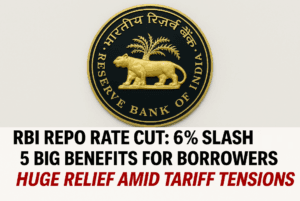RBI Repo Rate Cut: 6% Slash Sparks 5 Big Benefits for Borrowers – Huge Relief Amid Tariff Tensions!
The Reserve Bank of India has reduced the repo rate by 25 basis points, bringing it down to 6%, marking the second cut this year after February’s drop to 6.25%. This move is expected to ease borrowing costs and lead to lower EMIs for loans, offering relief to consumers. RBI Governor Sanjay Malhotra stated the decision was unanimous and aimed at supporting growth amid rising global uncertainties. The recent US tariffs on Indian exports have added pressure, but the RBI remains confident in managing domestic economic stability.
Encouraging signs are emerging in agriculture, manufacturing, and urban spending, with the services sector also showing resilience. Inflation remains under control, helped by falling food prices, which gave the central bank more room to act. Despite global challenges, bank and corporate balance sheets are reportedly healthy. The GDP growth forecast has been slightly lowered to 6.5%, reflecting caution but continued optimism about India’s economic trajectory.

RBI Repo Rate Cut: 6% Slash Sparks 5 Big Benefits for Borrowers – Huge Relief Amid Tariff Tensions!
In a move aimed at easing financial pressure on borrowers, the Reserve Bank of India (RBI) has announced a reduction in its key interest rate—the repo rate—from 6.25% to 6%. This 0.25% cut, the second this year after a similar move in February, is expected to make home, auto, and personal loans more affordable for consumers. Lower interest rates typically translate to reduced monthly installments (EMIs), offering relief to households and businesses.
The repo rate determines the cost at which the RBI lends funds to commercial banks. A lower rate means banks can borrow money more cheaply, often encouraging them to pass on the benefits to customers through cheaper loans. RBI Governor Sanjay Malhotra stated that the decision was backed unanimously by the Monetary Policy Committee (MPC), the body responsible for setting India’s monetary policy.
Global Trade Tensions Influence Decision
Governor Malhotra highlighted growing uncertainties in the global economy, particularly after the United States imposed new tariffs on Indian goods under former President Donald Trump’s administration. These tariffs, part of broader trade tensions, have raised concerns about slower global growth, which could hurt India’s export sector. “Global trade disputes may dampen worldwide economic activity, indirectly affecting India’s export performance,” Malhotra explained. However, he emphasized the central bank’s focus on shielding domestic growth from external shocks.
Domestic Economy Shows Resilience
Despite global headwinds, the RBI expressed confidence in India’s economic fundamentals. Key sectors such as agriculture, manufacturing, and services are showing positive trends. Recent monsoon forecasts suggest a strong agricultural season, which could boost rural incomes and spending. Meanwhile, manufacturing activity has gained momentum, and the services sector—a major contributor to GDP—continues to expand steadily.
Urban consumer spending is also on the rise, supported by stable income growth and improved access to credit. Additionally, Malhotra noted that banks and corporations have strengthened their financial health, with healthier balance sheets compared to previous years. This stability, he argued, positions India to weather global challenges more effectively.
Inflation Under Control, But Growth Forecast Trimmed
A significant factor behind the rate cut is the manageable inflation rate. Consumer prices have remained within the RBI’s target range, largely due to declining food prices. Stable fuel costs and moderate demand have also helped keep inflation in check. However, the central bank remains cautious about potential risks, including volatile global oil prices and erratic monsoon patterns.
While the RBI remains optimistic about domestic growth, it has slightly lowered India’s GDP growth projection for the current financial year by 0.2%, bringing it to 6.5%. This revision reflects concerns about weaker global demand and its spillover effects on trade and investment.
What This Means for Borrowers and Savers
For individuals and businesses, the rate cut signals cheaper borrowing costs. Banks are expected to reduce interest rates on loans, particularly home loans, which could revive demand in the real estate sector. Entrepreneurs and small businesses may also benefit from lower-cost credit, aiding expansion and job creation.
On the flip side, savers might see lower returns on fixed deposits and savings accounts as banks adjust their deposit rates downward. Economists advise borrowers to negotiate better terms with lenders and consider refinancing existing loans to maximize savings.
Looking Ahead
The RBI reiterated its commitment to balancing growth and inflation. While supporting economic activity remains a priority, the central bank warned it would not hesitate to adjust its stance if inflation risks escalate. Governor Malhotra stressed the need for continued reforms to boost productivity, attract investment, and create jobs.
Analysts suggest that further rate cuts in 2025 are unlikely unless global conditions worsen or domestic growth falters unexpectedly. For now, the focus remains on sustaining India’s economic momentum through targeted policies and responsive monetary measures.
In summary, the RBI’s rate cut aims to cushion the economy from global trade disruptions while encouraging domestic spending and investment. With inflation under control and key sectors performing well, India appears poised to navigate near-term challenges—provided global uncertainties do not intensify.
You must be logged in to post a comment.